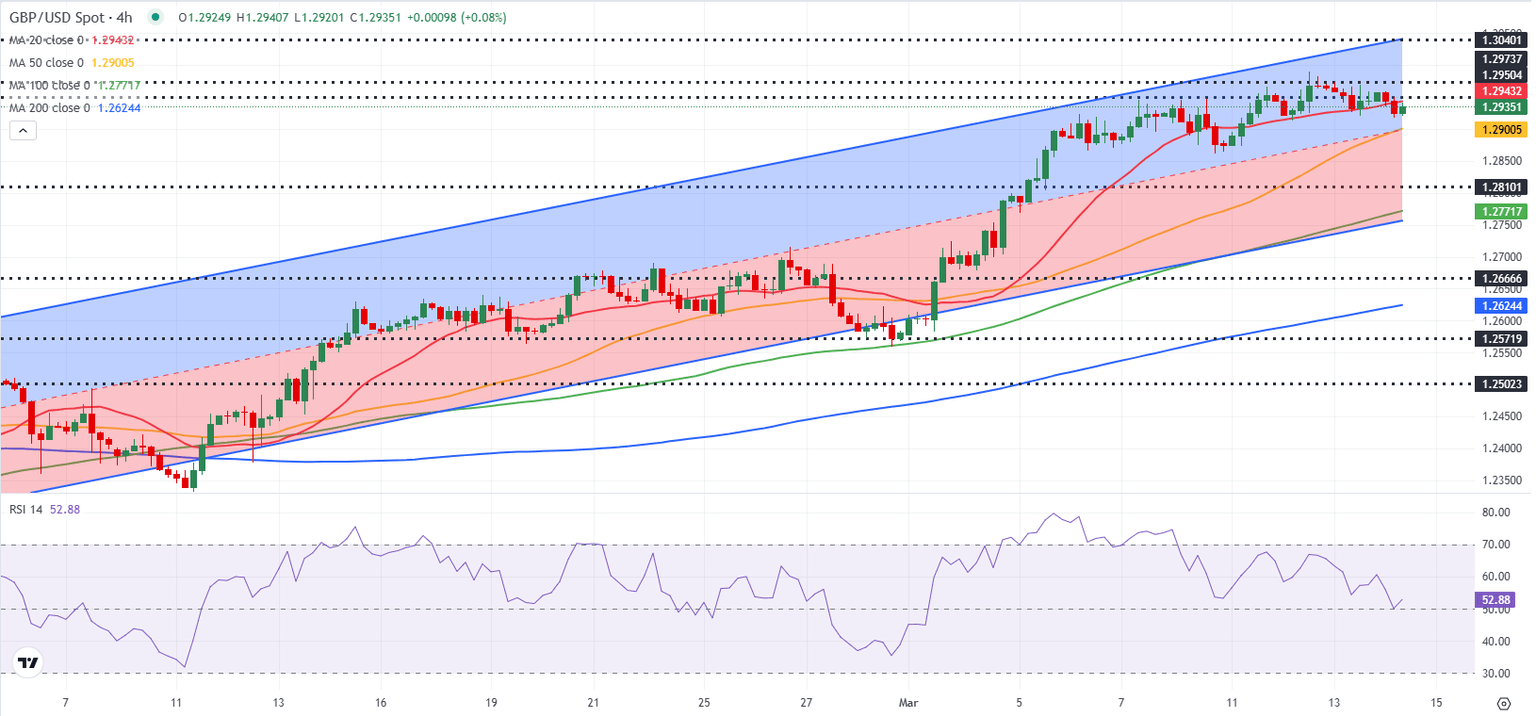GBP/USD Forecast: Pound Sterling struggles to benefit from upbeat mood after weak UK data
- GBP/USD stays below 1.2950 after posting small losses on Thursday.
- Disappointing macroeconomic data releases from the UK make it difficult for Pound Sterling to gather strength.
- The near-term technical outlook highlights a loss of bullish momentum.

After closing marginally lower on Thursday, GBP/USD stays on the back foot and trades below 1.2950 in the European session on Friday. Although the near-term technical outlook is yet to point to a buildup of bearish momentum, the pair could have a difficult time staging a rebound after disappointing data releases from the UK.
British Pound PRICE This week
The table below shows the percentage change of British Pound (GBP) against listed major currencies this week. British Pound was the weakest against the Euro.
| USD | EUR | GBP | JPY | CAD | AUD | NZD | CHF | |
|---|---|---|---|---|---|---|---|---|
| USD | -0.37% | -0.12% | 0.55% | 0.37% | 0.01% | -0.09% | 0.51% | |
| EUR | 0.37% | 0.22% | 0.92% | 0.76% | 0.47% | 0.25% | 0.77% | |
| GBP | 0.12% | -0.22% | 0.65% | 0.50% | 0.26% | -0.02% | 0.62% | |
| JPY | -0.55% | -0.92% | -0.65% | -0.18% | -0.47% | -0.72% | 0.04% | |
| CAD | -0.37% | -0.76% | -0.50% | 0.18% | -0.40% | -0.46% | 0.11% | |
| AUD | -0.01% | -0.47% | -0.26% | 0.47% | 0.40% | -0.22% | 0.35% | |
| NZD | 0.09% | -0.25% | 0.02% | 0.72% | 0.46% | 0.22% | 0.68% | |
| CHF | -0.51% | -0.77% | -0.62% | -0.04% | -0.11% | -0.35% | -0.68% |
The heat map shows percentage changes of major currencies against each other. The base currency is picked from the left column, while the quote currency is picked from the top row. For example, if you pick the British Pound from the left column and move along the horizontal line to the US Dollar, the percentage change displayed in the box will represent GBP (base)/USD (quote).
The data published by the UK's Office for National Statistics (ONS) showed early Friday that the UK's Gross Domestic Product (GDP) contracted by 0.1% on a monthly basis in January. This reading followed the 0.4% growth recorded in December and came in below the market expectation for an expansion of 0.1%.
The ONS further reported that Industrial Production and Manufacturing Production fell by 0.9% and 1.1%, respectively, on a monthly basis. Both of these prints came in worse than analysts' estimates, weighing on Pound Sterling.
The US economic calendar will feature the University of Michigan's preliminary Consumer Sentiment Index data for March. A noticeable deterioration in consumer confidence could cause the US Dollar to come under pressure and allow GBP/USD to limit its losses.
Meanwhile, US stock index futures rise between 0.5% and 0.1% in the European session on Friday. So far, Pound Sterling has failed to benefit from improving risk mood. Nevertheless, a risk rally in the American session could hurt the USD and support GBP/USD.
GBP/USD Technical Analysis
GBP/USD's last candle on the 4-hour chart closed below the 20-period Simple Moving Average (SMA). Additionally, the Relative Strength Index (RSI) indicator retreated to 50, reflecting a lack of buyer interest.
On the downside, 1.2900 (round level, static level, mid-point of the ascending regression channel) aligns as first support before 1.2850 (static level) and 1.2800 (200-day SMA). Looking north, resistances could be spotted at 1.2970 (static level), 1.3000 (round level, static level) and 1.3040 (upper limit of the ascending channel).
Pound Sterling FAQs
The Pound Sterling (GBP) is the oldest currency in the world (886 AD) and the official currency of the United Kingdom. It is the fourth most traded unit for foreign exchange (FX) in the world, accounting for 12% of all transactions, averaging $630 billion a day, according to 2022 data. Its key trading pairs are GBP/USD, also known as ‘Cable’, which accounts for 11% of FX, GBP/JPY, or the ‘Dragon’ as it is known by traders (3%), and EUR/GBP (2%). The Pound Sterling is issued by the Bank of England (BoE).
The single most important factor influencing the value of the Pound Sterling is monetary policy decided by the Bank of England. The BoE bases its decisions on whether it has achieved its primary goal of “price stability” – a steady inflation rate of around 2%. Its primary tool for achieving this is the adjustment of interest rates. When inflation is too high, the BoE will try to rein it in by raising interest rates, making it more expensive for people and businesses to access credit. This is generally positive for GBP, as higher interest rates make the UK a more attractive place for global investors to park their money. When inflation falls too low it is a sign economic growth is slowing. In this scenario, the BoE will consider lowering interest rates to cheapen credit so businesses will borrow more to invest in growth-generating projects.
Data releases gauge the health of the economy and can impact the value of the Pound Sterling. Indicators such as GDP, Manufacturing and Services PMIs, and employment can all influence the direction of the GBP. A strong economy is good for Sterling. Not only does it attract more foreign investment but it may encourage the BoE to put up interest rates, which will directly strengthen GBP. Otherwise, if economic data is weak, the Pound Sterling is likely to fall.
Another significant data release for the Pound Sterling is the Trade Balance. This indicator measures the difference between what a country earns from its exports and what it spends on imports over a given period. If a country produces highly sought-after exports, its currency will benefit purely from the extra demand created from foreign buyers seeking to purchase these goods. Therefore, a positive net Trade Balance strengthens a currency and vice versa for a negative balance.
Premium
You have reached your limit of 3 free articles for this month.
Start your subscription and get access to all our original articles.
Author

Eren Sengezer
FXStreet
As an economist at heart, Eren Sengezer specializes in the assessment of the short-term and long-term impacts of macroeconomic data, central bank policies and political developments on financial assets.

















